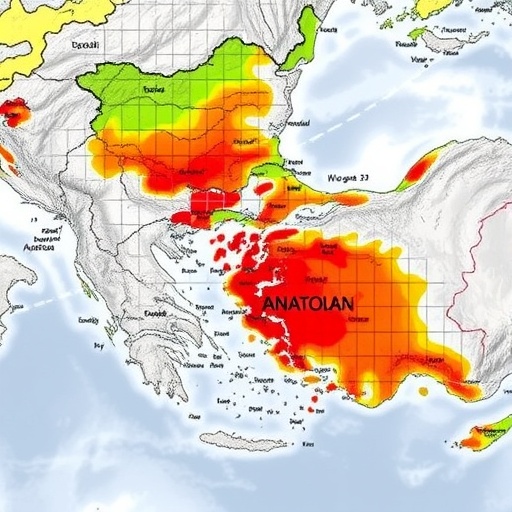Recent geodetic studies have shone a spotlight on the intricate dynamics of the East Anatolian Fault (EAF), a significant tectonic feature bridging the gulf between the Arabian and Eurasian plates. Researchers like Han, Yu, and Li have meticulously analyzed the slip behaviors associated with this fault, revealing critical insights into its pattern of movement and the seismic risks it poses. Geodetic observations have unveiled complex interactions between fault segments, bringing to the forefront the concepts of slip complementarity and deficits, which may have profound implications for understanding earthquake hazards in the region.
The East Anatolian Fault is characterized by a right-lateral strike-slip movement that has been tracked over several decades. The movement results from the ongoing collision of the Arabian plate with the Eurasian plate, leading to the accumulation of stress along fault lines. This study emphasizes the importance of high-resolution geodetic data to comprehend these tectonic movements more fully. Utilizing advanced satellite-based measurements, researchers have documented the unique characteristics of slip rates along different segments of the fault, highlighting the variability in slip behavior that challenges previous models of fault interactions.
One key finding from the study indicates that slip rates on the EAF are not uniform. Different segments of the fault exhibit varying rates of displacement, leading researchers to propose the notion of slip complementarity. This concept suggests that segments of the East Anatolian Fault may accommodate stress differently during seismic events, which necessitates a detailed understanding of how these segments interact. Through this multifaceted lens, the study unravels the complex relationships between stress accumulation, release, and potential future seismicity along the fault.
Geodetic observations have also illuminated a deficit in slip across the fault, which could signal an accumulation of stress that may contribute to future seismic activity. This phenomenon points toward a critical aspect of tectonic fault behavior: the interaction between different fault segments and their potential to generate large earthquakes. Understanding this slip deficit is paramount for seismic hazard assessments in southeastern Turkey, where densely populated regions lie perilously close to the fault line.
The researchers employed a combination of InSAR (Interferometric Synthetic Aperture Radar) and GPS (Global Positioning System) data to analyze ground displacement. This dual approach allowed for an unprecedented granularity of data, enabling them to map deformation patterns with high precision. By integrating these two technologies, the study provides a comprehensive view of how the fault’s segments are actively deforming, painting a rich picture of the ongoing tectonic processes at play.
In addition to revealing slip rates and deficits, the geodetic analysis emphasizes the importance of characterizing the fault’s mechanical behavior. Understanding the mechanical attributes of the EAF lends insight into not only its current activity but also the potential for future seismic events. The research hypothesizes that variations in fault friction and material properties along different segments influence how stress is stored and released. This interplay is critical for predicting when and where significant earthquakes may occur in the region.
A particularly striking outcome of the research is the proposal for a new theoretical framework to understand fault interactions along the EAF. The authors suggest that other regions exhibiting similar fault dynamics could benefit from these insights, offering a roadmap for future studies aimed at mitigating seismic risks. By establishing a baseline for analyzing slip complementarity, this framework could transform how scientists and policymakers approach earthquake preparedness in fault-prone areas worldwide.
The findings underscore a crucial component of earthquake forecasting: the need for continuous monitoring and data collection. The authors advocate for the expansion of geodetic networks in seismically active regions to capture real-time data on tectonic movements. With advancements in satellite technology and data processing, researchers can enhance their capabilities to foresee changes in slip behavior that may lead to seismic events.
Communities residing near the EAF are particularly vulnerable due to the threat posed by potential large-scale earthquakes. Effective risk management strategies rely on an accurate understanding of seismic hazards. As such, the insights derived from this study are instrumental in informing building codes and disaster preparedness initiatives in neighboring towns and cities. By disseminating accurate information about the fault’s behavior, policymakers can implement strategies that emphasize resilience and strengthen public safety measures.
In summary, Han, Yu, and Li’s groundbreaking research on the East Anatolian Fault using cutting-edge geodetic observations presents vital information that advances our comprehension of fault behavior and earthquake risks. The introduction of slip complementarity and the identification of slip deficits provide critical understanding that could reshape how scientists monitor seismic hazards. As we continue to grapple with the realities of living in an earthquake-prone world, the call for more nuanced, data-driven assessments of fault dynamics is more important than ever.
In conclusion, this thorough analysis paves the way for a deeper understanding of tectonic interactions and the inherent risks they pose. It emphasizes the interconnectedness of fault systems and the necessity for ongoing research and monitoring. As we look toward the future, the implications of these findings will undoubtedly reverberate through the scientific community and beyond, enhancing our preparedness and resilience against seismic threats.
Subject of Research: East Anatolian Fault dynamics and seismic risks.
Article Title: Slip complementarity and deficit of the East Anatolian Fault revealed by geodetic observations.
Article References:
Han, B., Yu, C., Li, Z. et al. Slip complementarity and deficit of the East Anatolian Fault revealed by geodetic observations.
Commun Earth Environ (2025). https://doi.org/10.1038/s43247-025-03025-2
Image Credits: AI Generated
DOI: 10.1038/s43247-025-03025-2
Keywords: East Anatolian Fault, geodetic observations, slip complementarity, seismic risk, InSAR, GPS, fault dynamics, earthquake preparedness.




